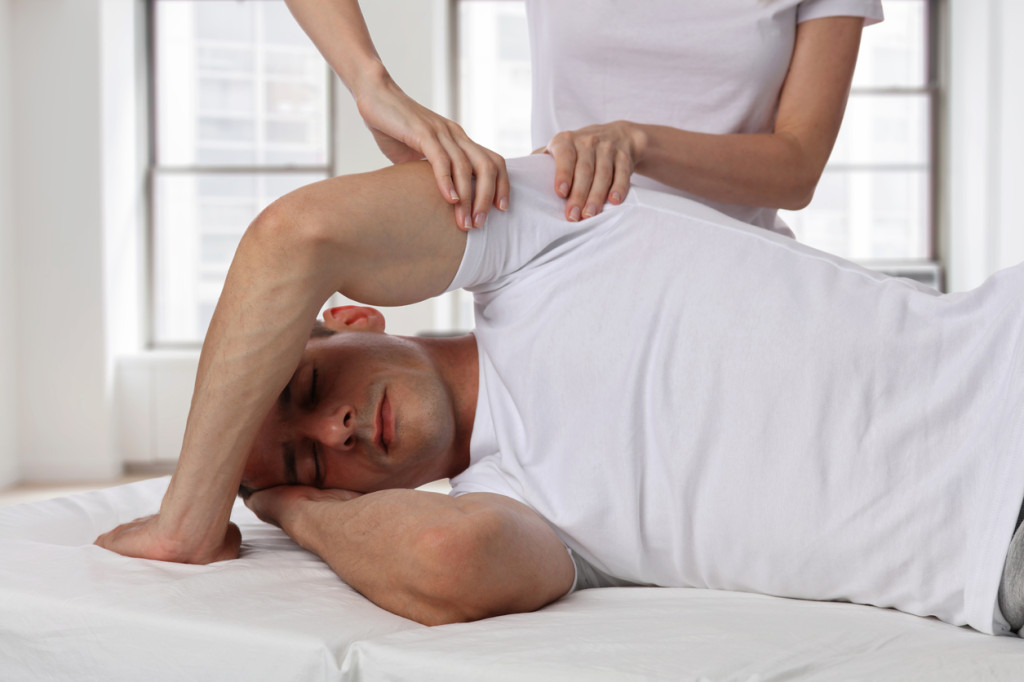If you have ever suffered from some type of shoulder pain then you know that it can stop you from normal everyday activities quickly. But what can be done to ease the pain as you are healing? We are so glad you asked! We found a great article to help highlight the important role that we can play on your road to recovery.
Chiropractic care is commonly sought by people seeking relief from neck or back pain. Chiropractors are not limited to only care of the spine, however. Most chiropractors are trained to adjust and treat extremities including knees, smaller joints such as the toes, and the shoulders. Sometimes shoulder pain is caused by joint irritation, while other times it is caused by tissue irritation. Chiropractic relief for shoulder pain can often be achieved through manipulation and other treatments.
Shoulder Anatomy
Chiro Community, a website for patients and chiropractic professionals, states that the shoulder joint is the most mobile joint in the body. It is surrounded by nerves, tendons, bursa and other tissues which can all be irritated and cause pain. Tendons help attach muscle to bone while ligaments attach bone to bone. Four tendons make up the rotator cuff: supraspinatous, infraspinatous, subscapularis and teres minor. All of these originate from the back near the shoulder blade and attach to make a cuff or circle around the glenoid fossa, or shallow bowl, of the shoulder blade, also called the scapula. The cuff and joint are further strengthened by cartilage and ligaments.
Testing and Imaging
Tendons, muscles or ligaments around the joint can stretch and tear causing pain. Pain further up the body, for example, in the neck, can also refer pain into the shoulder joint as can trigger points in the muscle, or a “knot.” Diagnostic examination will include determining range of motion of the neck and shoulders as well as testing of the muscle and related sensations. Specific orthopedic tests meant to isolate certain parts of the rotator cuff or neck help determine pain generators. If the pain and symptoms are unresponsive to initial treatment, imaging such as a CT scan or MRI can further help identify origin of the problem.
Adjustments
Even with all of the tissue surrounding and supporting the shoulder joint, it can shift out of alignment causing the muscles and ligaments to pull differently. This leads to muscle spasms, inflammation and pain. Gentle adjustments to the shoulder can be performed to distract the joint or shift it forward or backward, depending on symptoms. Adjusting the shoulder may involve the use of a speeder board, drop table piece or reflex-type hammer tool as well as manual adjustment. Additionally, having the neck and upper back adjusted will also help relieve shoulder discomfort.
Posture
Treating shoulder pain may involve adjusting work ergonomics to allow for correct posture throughout the day. Physio Adviser, an Australian-based physical therapy website, explains that work or recreation involving long periods of sitting can lead to postural syndrome, in which the shoulders roll forward and in toward the chest while the upper back slouches forward. The head juts forward at the chin and centers over the chest. Correct upper body posture is achieved when the ears line up over the shoulders and the shoulders are down, relaxed and back. The upper and mid-back are in line with the lower back and hips.
Exercise
Simple shoulder exercises such as Codman’s arm swings help warm up the shoulder tissues before a work out. The Nicholas Institute of Sports Medicine and Athletic Trauma says this exercise is performed by leaning forward until the shoulder hangs perpendicular to the ground and swinging the arm in small circles in both directions. Varying the size of the circles and switching sides after 30 seconds is recommended, with the goal being to work up to several minutes of exercise. Other exercises will involve the use of Therabands, colored bands of rubber tubing that provide various resistances to strengthen specific rotator muscles. With postural syndrome, strengthening the external rotators rhomboids and lower traps is useful.
This article was originally published on livestrong.com.

